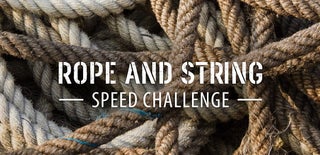Introduction: Spring String Eggs
Spring is Coming!
Today was an unusual Winter Day in New England. Temperatures where in the mid 50s, and for a late February day, it gives the illusion that Spring is around the corner.
With the promise of Spring comes Easter, and what better way to get ready for it than to do these simple Easter String Eggs.
Step 1: What You Will Need
- String (any type). I'm using some embroidery floss 100% cotton, but twine and other types of string work too.
- Craft Glue (plain white school glue works too)
- Water
- Plastic Container. The wider the container, the less likely your string will tangle while it soaks.
- Small Balloons (water balloons work best for smaller Easter Eggs)
- Balloon pump (VERY useful when using water balloons)
- Candy (optional)
- Place to work that can get messy (or make sure to protect it)
- Place to hang the string to dry and some clips or clothespins
- Pin and tweezers (not in pictures)
Step 2: Preparing the Easter Eggs
1. Add equal parts craft glue and water into your plastic container and mix well. If it's too watery, add more glue, it should look thicker than milk. I used 1/2 cup of each and it was enough for 4-5 embroidery floss strands.
2. Unravel the string of your choice. I'm using embroidery floss strands that are 8.75 yards / 8 meters long each. Make sure the string doesn't have any knots or tangles.
- While unraveling place string in plastic container with water/glue mix. Make sure that the string doesn't tangled while it soaks.
- Leave the soaked end of your strand in a way you can easily identify it. It's easy for it to get lost and string can get tangled while you look for it.
- Once the string is fully soaked, it's ready to be used. Depending on string thickness 30 seconds to 1 minute.
3. Blow up balloon to desired size and tie it.
4. Take the end of the soaked string and place it on the balloon. Start at the knot of the balloon and wrap the string across it several times to make it more sturdy.
5. Continue wrapping the string in any desired direction.
- While wrapping, try to remove the excess water/glue in the strand with your fingers, to make it less messy.
- Make sure that it doesn't leave big gaps between strings. View embedded video to see process.
- If you want to place something inside (like chocolate eggs or jelly beans) leave one small gap to insert them trough. The gap can be be smaller than what you're inserting, as the string will be a little flexible at the end.
6. When you have finished wrapping the first strand, you can repeat the process to make the string egg thicker and sturdier. Try all kinds of colors combinations!
Step 3: Letting Them Dry
Once the balloon is covered to your liking, hang it to dry. Depending on how soaked the string is the egg will drip a little.
Leave it 24-48 hrs to dry completely.
Additional Observation: Once the string starts to dry, it will begin to separate from the balloon. You will hear some creaking, so don't freak out.
Step 4: After It Dries
After 24-48 hours:
- Take your dried egg and make sure the balloon is completely separated from the string all around. You will be able see a gap between the string and the balloon (like the picture above).
- Use a needle or another small sharp object to pop the balloon. Using tweezers, take the balloon off the egg. Don't use too much force while holding the egg, as the glued strings can separate.
- If you want to place candy inside the egg, carefully pass them through the small opening you left while wrapping the string or through the biggest one you can find.
- If string gets stuck to the balloon or your string egg collapses, please see the Troubleshooting Section for some suggestions.
Step 5: Finished!
Now your string eggs are ready to be used as decoration or for a fun Easter Egg Hunt!
Step 6: Some Troubleshooting
I encountered some difficulties during the making of these string eggs. Here are some recommendations from what I've learned:
- Using twine will need more water/glue mix, as well as more time to dry. However, the result is much sturdier than using embroidery floss.
- Using party balloons (12 inches ) instead of water balloons will give you bigger string eggs. But I found that they will have a more rounder shape and will stick to the string even when dried. This will make it more difficult to extract the balloon from the finished project. One of the my string eggs collapsed on the bottom (blue string).
- Tying several times around the knot of the balloon will make it more difficult to remove it when string dries and the balloon pops. Try more to wrap the string loosely around this part of the balloon.
- If your string egg collapses it might be because of the following reasons.
- Too much water was used in the mix, or too little glue
- Project was not dry enough

Participated in the
Rope & String Speed Challenge









